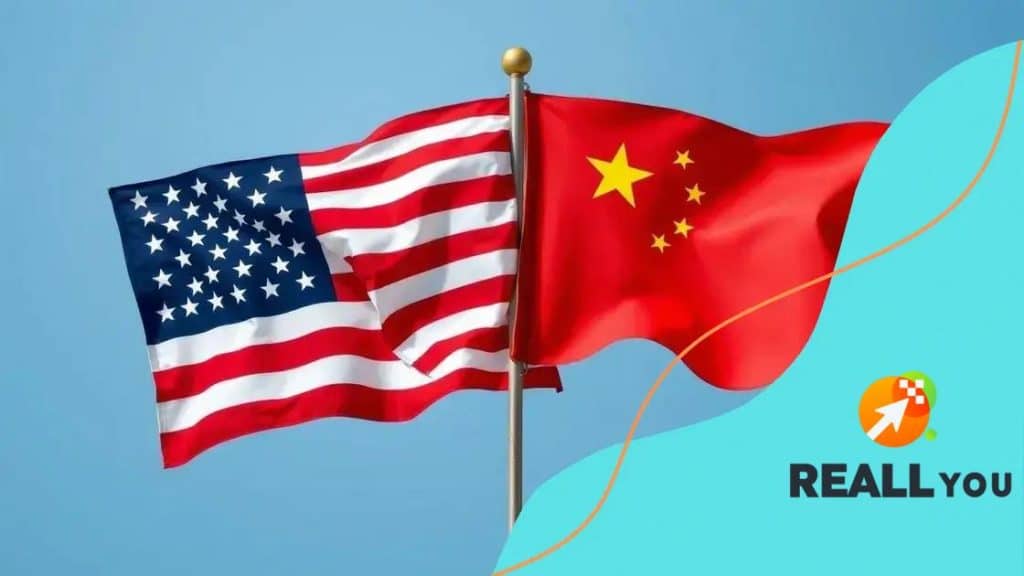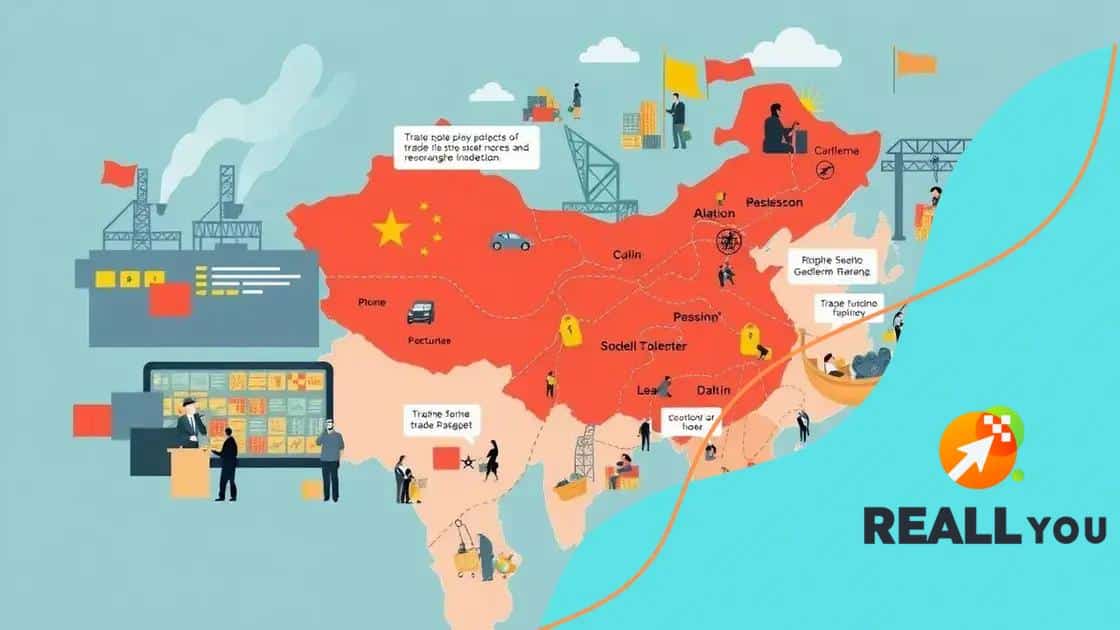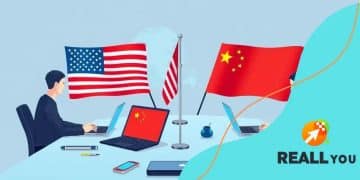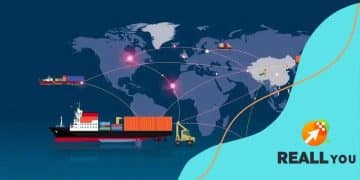US-China trade impacts: understanding the effects

Anúncios
US-China trade impacts include shifting economic dynamics, job market changes, technological competition, and increasing focus on sustainability, significantly influencing global trade practices and consumer behavior.
US-China trade impacts are felt far beyond the borders of these two nations. As policies shift, consumers and businesses alike wonder how their lives could change. Are you curious about the unfolding consequences?
Anúncios
Overview of US-China trade relations
The Overview of US-China trade relations reveals a complex and evolving partnership. These two economic giants have shaped the global market through their interactions, leading to a significant impact on various industries.
Anúncios
Historical Context
Since China joined the World Trade Organization in 2001, the trade dynamics have changed dramatically. The US and China have maintained a critical trading relationship, characterized by a mix of cooperation and competition.
Current Trade Figures
As of recent reports, the trade between the US and China exceeds $600 billion annually, making it one of the largest trading partnerships globally.
- Exports from the US to China largely include agricultural products.
- China’s exports to the US feature electronics and machinery.
- The trade balance often shows a deficit for the US, raising concerns among policymakers.
Significant tariffs have also been applied in recent years, particularly during the trade war that began in 2018. These measures were introduced in an attempt to address trade imbalances and protect domestic industries.
Impact on Global Economy
The ongoing US-China trade relations significantly influence the global economy. Businesses worldwide keep a close watch on any policy changes that could affect supply chains or pricing.
Furthermore, shifts in this relationship impact countries that rely on the US and China for trade. Nations may face increased uncertainty as they navigate the consequences of tariffs and trade agreements.
In conclusion, understanding the dynamics of US-China trade relations is vital for businesses and governments alike. This knowledge allows them to anticipate changes and adapt their strategies effectively.
Key sectors affected by trade changes

Examining the key sectors affected by trade changes between the US and China reveals significant implications for various industries. These sectors are intertwined with global supply chains and can be deeply influenced by policy shifts.
Agriculture
The agricultural sector is one of the most visible areas impacted by trade changes. The US exports a large amount of soybeans, corn, and other crops to China. However, when tariffs were imposed, many farmers faced lower prices and reduced demand.
- Reduced soybean exports highlight the uncertain market.
- Chinese tariffs led to immediate losses for US farmers.
- Despite challenges, some farmers are seeking new markets.
Shifts in agricultural imports and exports not only impact farmers but also consumers who are affected by fluctuating prices in grocery stores.
Technology
The technology sector is another critical area. Companies like Apple and Intel rely on both markets for production and sales. Any changes in tariffs or regulations can lead to increased costs for consumers and slower innovation.
Additionally, restrictions on certain technology transfers have also forced firms to reconsider their supply chains.
Manufacturing
Manufacturers often depend on parts and materials sourced from both countries. Disruptions in trade can cause delays in production, impacting everything from electronics to automotive sectors.
- Increased tariffs can lead to higher costs for manufacturers.
- Many firms are looking to diversify their supply chains.
- Manufacturers must be agile to adapt to changes quickly.
The implications stretch beyond domestic markets, affecting global trends and competitiveness. Trade changes create ripple effects felt by consumers, manufacturers, and entire economies. Businesses need to stay informed as these dynamics evolve to navigate potential challenges effectively.
Economic implications for the US
Understanding the economic implications for the US due to trade changes with China is crucial. This relationship directly influences growth, job markets, and financial stability.
Impact on Growth
Trade with China represents a significant portion of the US economy. Disruptions can slow down economic growth, leading to uncertainties in various sectors. When tariffs are imposed, businesses may struggle with increased costs, affecting their ability to invest and expand.
Job Market Effects
The job market is also influenced by shifts in trade policy. Factories and companies may lay off workers if their costs rise significantly. However, some sectors benefit from increased domestic production, which can create new jobs.
- The manufacturing sector may face layoffs due to higher input costs.
- Conversely, industries focusing on local products might see job growth.
- Trade agreements can lead to new openings in fields like logistics and transportation.
Workers need to adapt to changes and possibly reskill to align with the evolving job market.
Financial Stability
On a broader scale, trade relations impact the financial stability of the country. Increased tariffs often lead to inflation, which affects consumer spending. When prices rise, families may need to cut back on expenses, influencing overall economic health.
Furthermore, foreign investment flows can be affected, altering the landscape for startups and established businesses alike.
Investment and consumer confidence are linked to how these trade relations evolve. Understanding these implications helps policymakers and businesses navigate future challenges and opportunities.
Consequences for China’s market

The consequences for China’s market as a result of changing trade dynamics with the US are profound. These shifts not only reshape its economy but also impact various industries and consumer behavior.
Slower Economic Growth
As trade tensions increase, economic growth in China may slow down. China has relied significantly on exports to the US, and any restrictions can hinder its growth rate. Businesses may find it challenging to meet their financial goals amid rising tariffs.
Industries Affected
Several sectors are particularly vulnerable to changes in US trade policies. For example, the manufacturing industry faces uncertainty due to fluctuating demand from American buyers.
- Electronics manufacturing, a key pillar of China’s economy, could see reduced orders.
- The textile industry may struggle if imports from the US decrease.
- Automotive producers may experience shifts in sales and production strategies.
This pressure leads to companies seeking alternative markets or adjusting their business models, which can have long-term ramifications.
Consumer Impact
As trade barriers rise, consumers in China might face higher prices on imported goods. These increases can influence spending habits, leading to changes in shopping behavior. Consumers may turn to domestic products instead, affecting brand loyalty and market dynamics.
Moreover, ongoing trade disputes can create an atmosphere of uncertainty, prompting consumers to save rather than spend.
A deeper understanding of these consequences can help businesses and policymakers adapt to the evolving landscape in China’s market. Staying informed on trade relations allows for better strategy formulation as challenges emerge.
Future trends in US-China trade
Examining the future trends in US-China trade uncovers patterns that may shape global economy dynamics. As these two economic powers navigate their relationship, several factors will influence their trade policies.
Technological Innovation
One vital trend is the emphasis on technology. Both countries invest heavily in innovative technologies, which impact trade agreements. New technologies can lead to increased productivity and efficiency, but they also spark competition over market dominance.
- Artificial intelligence developments may reshape industries.
- Automation can change labor dynamics, affecting job markets.
- Policies will likely focus on protecting intellectual property rights.
Businesses will need to stay ahead to remain competitive as technology evolves.
Sustainable Practices
Sustainability is another crucial element. Growing public concern for environmental issues is leading both nations to consider greener trade practices. Industries may pivot to eco-friendly methods, influencing market demands and consumer behavior.
Policy Changes
Future policies between the US and China will likely continue evolving. Leaders from both countries face pressure to prioritize domestic interests while balancing international relations. This tension can result in both cooperation and conflict on trade agreements.
Trade negotiations might become more inclusive, engaging various stakeholders, including businesses and labor groups. Ongoing dialogues will shape how future agreements are structured.
As these trends unfold, businesses and consumers alike must remain adaptable. Understanding these shifts will be key in navigating the ever-changing trade landscape.
FAQ – Frequently Asked Questions about US-China Trade Impacts
What are the main economic effects of US-China trade changes?
The main economic effects include slower growth, shifts in job markets, and increased prices for consumers due to tariffs.
How do technological innovations influence trade relations?
Technological innovations create both competition and collaboration opportunities, impacting how businesses operate and trade.
What role does sustainability play in future trade policies?
Sustainability is becoming a priority, with both nations increasingly focusing on eco-friendly practices in trade.
How can businesses prepare for future trade dynamics?
Businesses can prepare by staying informed about trade policies and being adaptable to shifting market conditions.






